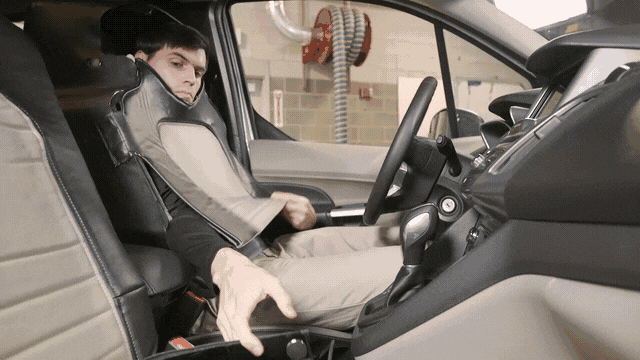Ford disguised an engineer as a seat for science
Washington — How do you make a car look driverless? Hide the driver inside a seat, for one, which is exactly what Ford Motor Co. did in a recent series of experiments.
The automaker worked with the Virginia Tech Transportation Institute throughout August to develop a way for the autonomous vehicles it plans to put on the road in 2021 to communicate with pedestrians.
Since there won’t be a driver to wave people through intersections or to give other nonverbal cues, the research team developed a light and placed it at the top of the vehicle’s windshield. The light could signal to those outside of the vehicle if the Transit Connect van was in autonomous drive mode, beginning to yield, or about to accelerate from a stop.

Much like the company’s partnership developing an autonomous delivery vehicle with Domino’s Pizza Inc., Ford engineers want to see how people interact with a vehicle they believe to be truly driverless — even if they aren’t. For the Domino’s experiments, Ford tinted the windows to hide the drivers.
During the month-long experiment in August, Ford put a driver in a “seat suit” that covered the occupant’s torso and head, leaving the driver’s hands free to control the wheel from their lap. The team collected 150 hours of data from roughly 1,800 miles of driving around Arlington, Virginia.
“It takes a couple of exposures for people to understand what’s going on,” John Shutko, Ford’s human factors technical specialist, said at a demonstration in Washington. “The first time, at least virtual world, the vehicle drives by. People don’t understand it.”
The company collected data from cameras mounted on the outside of the study vehicle. Ford said the signal — a bar of LED lights stretched across the top of the windshield — was activated more than 1,650 times during the tests.

The white lights moved from side to side across the bar to indicate a yield. They stayed solid white to indicate while in drive mode. And before the vehicle started, the lights rapidly blinked to signal pedestrians it was about to move.
“We considered symbology, text and everything else,” he said. “You put text up there and you have to translate across different languages. People think symbols are great. The recognition rate for symbols that we all think ‘hey everyone knows those’ is actually really, really poor. Rear defrost, everyone kind of knows what that symbol is, but the recognition rate is not even above 50 percent.”
The testing attracted a lot of attention in Washington when the vehicle was spotted by a local TV reporter in early August who followed it with a camera.
“Brother, who are you? What are you doing? I’m with the news, dude,” the reporter with Washington’s NBC affiliate, Adam Tuss, said in a video that went viral. “Dude, can you pull over and we can talk for a second?”
Andy Schaudt, director of the Virginia Tech Transportation Institute’s Autonomous Vehicle Project, said researchers were hesitant to reveal too much information about their study, even after it was discovered by a reporter.
“Ultimately we wanted to finish data collection before we started giving everybody all the information about it because as soon as people get more educated about these lights then their behavior could be biased,” he said. “If they get educated about the fact that we’re hidden inside of a seat suit, they could change the whole point of the study and that’s to see its natural environment and look at behaviors.”
He added: “We did mention a little bit about it at the time when it kind of got discovered in early August, just so that we could help delay concerns that it wasn’t some prank. There were legitimate reasons why we’re doing it, and kind of took the vehicle off for a couple of days and let it quiet down and then continue moving forward so that we could get quality data.”
ithibodeau@detroitnews.com
Twitter: @Ian_Thibodeau